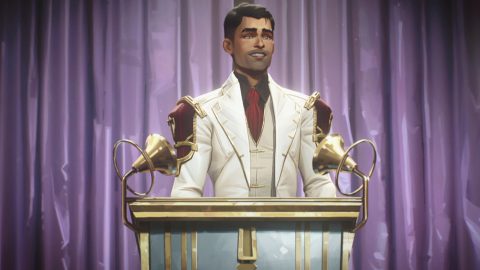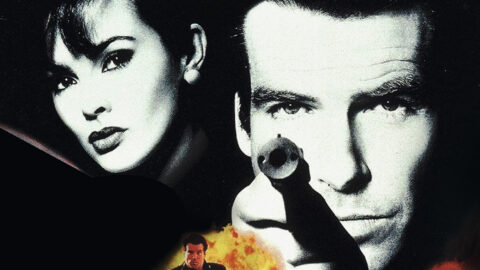
In Starfield, the future is bright. By the 24th century, when the futuristic role-playing game (RPG) is set, humanity has made unimaginable scientific strides, mastering the art of space travel and building vast cities on distant worlds. Sure, everyone is eating nondescript food called Chunks, Earth has been destroyed, and we’re recovering from a devastating intergalactic war, but hey – every galaxy has its problems.
- READ MORE: The best RPGs you can play in 2023
Starfield lets players live out their own sci-fi fantasy within that universe. You can be a gunslinging bounty hunter, searching for criminals across the stars, or a pilot ferrying copper shipments between moons.
Whatever your wildest dreams may involve, you’ll have to start small. Players begin their adventure as an intergalactic miner, using lasers to carve minerals out of faraway planets. After digging up a strange metal artifact, you suffer mysterious visions and are whisked away by Constellation – an eclectic group of explorers who believe humanity isn’t alone in the cosmos.

As their newest member, it’s your job to track down artifacts that prove their theory. This main quest is captivating, but it’s also an excuse to get out there and explore the many star systems that developer Bethesda Softworks’ has created. The scale of Starfield is difficult to grasp – there are hundreds of locales to discover, with just as many side quests to distract you from the plot.
Sometimes, that scale can be a hindrance. In previous Bethesda games such as Fallout 4 or The Elder Scrolls 5: Skyrim, venturing away from the beaten path is rewarded with new stories that feel totally unique. That’s been lost in Starfield’s vast scale. There are infinitely more places to visit, but most are identical – a sea of nameless research labs, mines, and outposts – fun to shoot through for a few minutes, but otherwise forgettable.
A lot of filler missions will send you to clear these places of gun-toting rogues, but Starfield’s longer tales are much more memorable. One highlight includes infiltrating the Crimson Fleet, a brutal faction of spacefaring pirates that you can either dismantle from within or pledge your loyalty to. Others include being stalked by a monstrous Alien-inspired Terrormorph, or pulling strings to ensure a shady corporate deal runs smoothly.

The game’s larger urban dwellings are vibrant tapestries, with many threads you’ll be eager to unravel. We spent hours exploring the rain-slick streets of Neon, a fishing platform that was transformed into a centre of commerce and corruption when its inhabitants discovered a recreational drug could be made using local fish. Akila City’s wild west atmosphere is less fishy, but just as compelling. You’re introduced to the settlement during an ongoing bank robbery, and if you choose to intervene, you can sign up with the Frontier Rangers to dish out justice across the Settled Systems’ frontier.
Unless you’ve created a smooth-talking protagonist who can chat their way out of any situation, most situations in Starfield end in a shootout. With an arsenal of flashy guns at your disposal, that’s not necessarily a bad thing. Blasting through a hijacked casino in zero-gravity is a thrill, and robust weapon customisation means you can mod anything to suit your playstyle.
Weapons aren’t the only thing you can tweak. Role-playing is at the heart of Starfield, and a robust character creation screen lets you decide everything from your looks to where you’re from – and if you can still visit your parents for dinner. Even better, ship customisation is truly remarkable, though the game does a poor job of explaining how anything works – you’ll learn through trial and error, tacking on infirmaries and turrets until something breaks.

But once you can tell your grav drive and reactors apart, building is a joy. Ships you buy, find or steal can be upgraded in parts, while savvy shipwrights can build entirely new vessels from scratch. Piloting feels fantastic – decked-out warships are sluggish yet powerful, while nimble fighters can fly rings around their weightier adversaries. Most dogfights come down to keeping your weapon systems locked-on and firing until the enemy ship explodes spectacularly, but destroying someone’s engines will also let you board and even hijack their craft.
On top of that, composer Inon Zur’s score is phenomenal, capturing the excitement and danger of space with a rousing orchestral suite. However, Starfield’s spirit of adventure is let down by the fact that most exploring is done without your involvement. Taking off or landing your ship is hands-off, carried out with a loading screen. Instead of travelling between planets, you select your destination only to fly into another loading screen. While it’s likely a technical necessity, it’s also hugely jarring.
Issues like this add up, and at times Starfield is ambitious to a fault. It’s capable of turning an entire universe into a thrilling playground, but falls short of truly immersing you in that fantasy. Starfield is a must-play game for sci-fi fans, but its shortcomings prevent it from becoming a complete triumph.
Starfield is available on PC and Xbox Series X|S. We reviewed it on PC.
Verdict
Starfield promises so much, but comes up short of perfection. Despite lacking the thoroughness of Bethesda’s prior open-world games, a wealth of gripping stories and role-playing potential will likely keep players hooked for years.
Pros
- Rewarding customisation options for characters, equipment and ships
- Bethesda’s finest gunplay to date
- One of the best sci-fi scores ever created
Cons
- Not enough unique locations
- Too many loading screens hurt immersion
The post ‘Starfield’ review: a dizzying adventure that shoots for the moon appeared first on NME.










